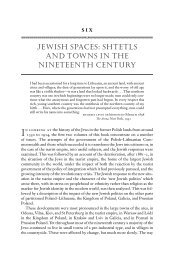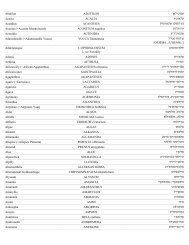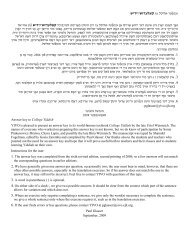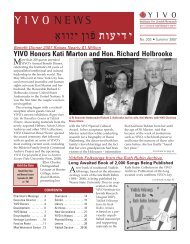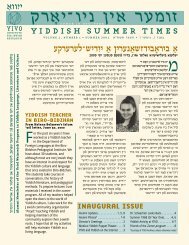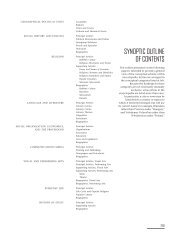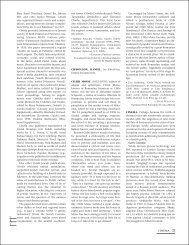t any plant names in Yiddish - YIVO Institute for Jewish Research
t any plant names in Yiddish - YIVO Institute for Jewish Research
t any plant names in Yiddish - YIVO Institute for Jewish Research
You also want an ePaper? Increase the reach of your titles
YUMPU automatically turns print PDFs into web optimized ePapers that Google loves.
XIV<br />
˘È„”È Ôȇ ËÏÚÂÂ≠ÔÒ˜ÈÂÂÚ‚ È„ Ÿ ¯ÚËÎÚ˘ È΄¯Ó<br />
have all referred countless times to <strong>Yiddish</strong> <strong>plant</strong> <strong>names</strong>, especially<br />
those with halakhic relevance. Among the <strong>Yiddish</strong> lexical items<br />
<strong>in</strong> rabb<strong>in</strong>ical responsa (Bar-El 1977) we f<strong>in</strong>d a variety of cherry<br />
(amaréln), 'leek', 'melon', 'pomegranate', 'anise', etc. The five species<br />
of gra<strong>in</strong> of ritual importance, <strong>for</strong> example – wheat, spelt, barley,<br />
rye, oats – have had <strong>Yiddish</strong> terms all through the history of<br />
Ashkenazic Jewry (Kosover 1958: 16-17).<br />
<strong>Yiddish</strong> terms <strong>for</strong> the five vegetable species that are halakhically appropriate<br />
<strong>for</strong> the Passover ceremony have been documented at least s<strong>in</strong>ce<br />
the 12th century (Kosover 1967: 243 ff). The <strong>Yiddish</strong> terms <strong>for</strong> 'charlock',<br />
'wormwood', 'leek', 'lettuce', 'horseradish', 'parsley', 'chervil', 'chicory', 'cherries',<br />
'sour cherries', 'apple', 'pear', 'plum', and 'nuts' are m<strong>any</strong> centuries old.<br />
Turn<strong>in</strong>g to modern <strong>Yiddish</strong> literature: the poet Nokhem Yud (1932:<br />
131-132) depicts <strong>in</strong> lov<strong>in</strong>g terms n<strong>in</strong>e species of mushroom <strong>in</strong> just one<br />
poem: kézerl, mókhever, buravík, talstúkhes, rízhikes, vólvenkes, vórtslshvémlekh,<br />
híntishe shvémlekh, púlvershvom. An average reader rem<strong>in</strong>isces<br />
<strong>in</strong> a letter to the editor 2 about seven species of mushroom <strong>in</strong> his native<br />
town.<br />
Morphophonemic changes<br />
The age-old <strong>Yiddish</strong> botanical terms, of course, underwent the morphophonemic<br />
changes that occurred <strong>in</strong> the <strong>Yiddish</strong> language through the ages.<br />
1. *Vermut 'wormwood' suffered the unstressed vowel reduction so<br />
common <strong>in</strong> <strong>Yiddish</strong>, turn<strong>in</strong>g <strong>in</strong>to vermet, attested <strong>in</strong> the writ<strong>in</strong>gs of<br />
Wertheim (1736), Khay-Odem (Bernste<strong>in</strong> 1955), Sotenever (1851).<br />
The word <strong>for</strong> 'carob' (Ceratonia siliqua) has developed from the<br />
German Bockshorn through bókshorn >bóksor >bókser >boks >boksl,<br />
all stages well attested <strong>in</strong> the literature and <strong>in</strong> the spoken language<br />
(the last two <strong>in</strong> Central <strong>Yiddish</strong>, especially <strong>in</strong> Transcarpathia).<br />
2. The <strong>in</strong>ternational term Fuchsia (<strong>in</strong> Polish: fuksja) is rendered either<br />
as fúksye (Golomb 1922; Horovits 1929; Yun<strong>in</strong> 1974), or as fuks<br />
(Abelson 1915), or as fuksl (Hirshbeyn 1916). But while fuks and<br />
fuksl are recent literary attempts at morphophonemic <strong>in</strong>tegration,<br />
probably consciously done, the same cannot be said of (a) nílebárlekh,<br />
yenkíper-bárlekh, kol-nídre-bárlekh, (b) shíkse-bárlekh or<br />
of (c) ertsisról-épelekh, reshkhóydesh-rétekhlekh, shíker-níslekh.<br />
a. At first blush the Southeastern <strong>Yiddish</strong> (hence<strong>for</strong>th SEY) series<br />
níle-bárlekh, kol-nídre-bárlekh, yenkíper-bárlekh, is <strong>in</strong>explicable.<br />
Folk etymology has <strong>in</strong>terpreted these terms to mean 'pears that<br />
mature around Yom Kippur' or the Day of Atonement. As a matter<br />
of fact, however, most varieties of pears mature <strong>in</strong> the fall,<br />
around that time of year. The correct explanation must be sought<br />
2) Louis Garber, <strong>in</strong> Forverts, New York, November 15, 1972.



